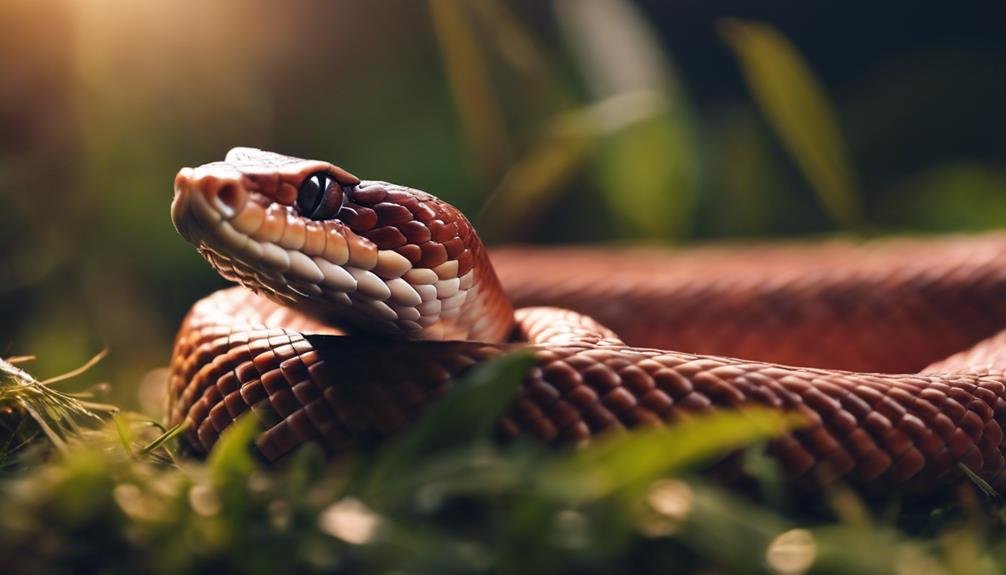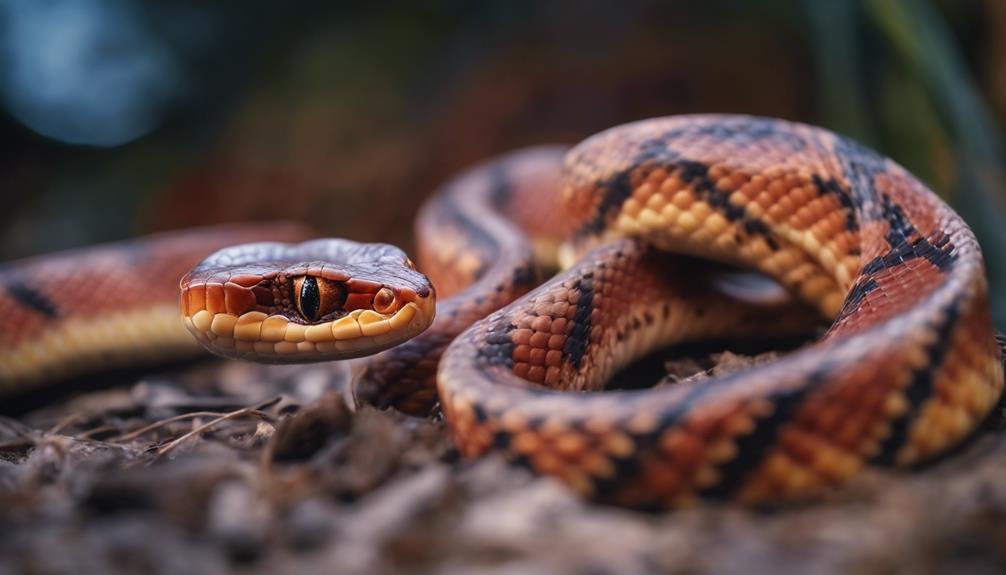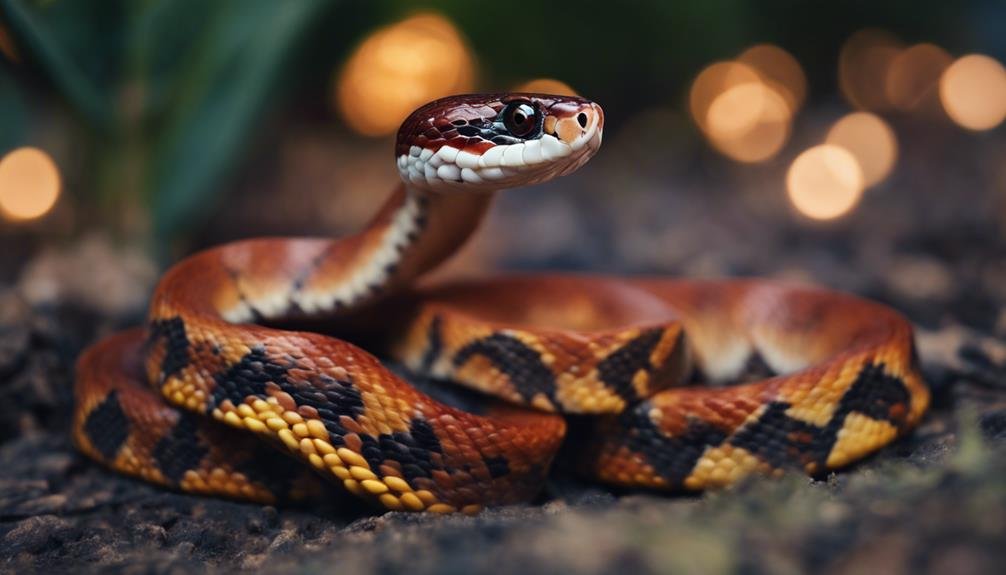You might have heard the rustling of leaves or the soft thud of exploration in the quiet of the night and wondered, are corn snakes really crepuscular, thriving in the dim twilight? Despite common beliefs, they're primarily diurnal creatures, basking in the daylight and resting when darkness falls. But it's not just about when they're active; it's what this means for your interaction and understanding of their behavior. If you've ever been puzzled by their nighttime activities or doubted the silence of their enclosure after dusk, you're on the brink of uncovering the nuances of their daily rhythms that could redefine how you perceive their needs and natural inclinations.
Key Takeaways
- Corn snakes are primarily diurnal, not crepuscular, active during the day.
- They exhibit nighttime exploration as part of their natural behavior.
- Nocturnal sounds and activities from corn snakes are typical and not a sign of distress.
- Twilight activity does occur, but it's an extension of their diurnal habits, not a primary crepuscular behavior.
- Environmental factors like lighting can influence their activity patterns, including early morning and nighttime activities.
Understanding Corn Snake Behavior
Observing your corn snake's behavior closely can help you understand its unique patterns of activity and ensure its health and happiness. Unlike purely crepuscular animals that are most active during twilight, corn snakes are generally diurnal, engaging in activities during both day and night. This doesn't mean they've a specific time when they're most active; instead, their activity levels can vary widely. Some might show more energy at night or early morning, influenced by environmental factors and individual preferences.
It's essential to pay attention to these variations to provide the care they need. For instance, if you notice your corn snake is more active at night, ensuring their habitat has the appropriate conditions during these hours is important. Engaging with a forum community dedicated to corn snakes can offer insights and advice tailored to your pet's behavior, enhancing your understanding and ability to cater to their needs.
The Myth of Nocturnal Noises
Dispelling a common myth, corn snakes aren't actually known for being noisy at night, despite some owners reporting occasional rustling sounds. These sounds, often attributed to the snake's nocturnal habits, are usually nothing more than the result of their natural behaviors. Understanding the nuances of corn snake activity can help you make sense of what you hear after dark.
Here are three key points to remember about corn snake nighttime activity:
- Nighttime Exploration: Corn snakes are known to be active during both day and night. Their nighttime movements in the vivarium, which might include searching for a comfortable spot or simply exploring, can lead to some noise. This is typical behavior and not a cause for concern.
- Vivarium Noises: The rustling or movement sounds you hear at night are often just the snake interacting with its environment. Whether it's moving through substrate or brushing against decor, these sounds are a normal part of their activity patterns.
- Activity Patterns: While corn snakes can exhibit a range of activity levels, they're not exclusively nocturnal or crepuscular. Their activity at night is just a continuation of their diurnal lifestyle, adjusting to their environment and needs.
Crepuscular Activity Explained


You might've heard the term 'crepuscular' and wondered how it relates to your corn snake's behavior.
However, it's important to know that corn snakes are actually diurnal, meaning they're active throughout the day and night, not just during twilight.
Understanding this distinction can help you better care for your pet and recognize their natural activity patterns.
Defining Crepuscular Behavior
Understanding crepuscular behavior is important when it comes to corn snakes, as this term describes animals that are most active during the twilight hours of dawn and dusk. However, it's key to note that corn snakes themselves don't strictly adhere to this pattern, showcasing a more versatile activity schedule.
Here's how crepuscular behavior stands out:
- Twilight Hunting, Predator Avoidance: Animals exploit the low-light conditions of dusk and dawn to hunt or evade predators, leveraging the reduced visibility.
- Circadian Rhythms, Light Sensitivity: These creatures have evolved circadian rhythms finely tuned to the subtle changes in light, enabling them to be most active during twilight.
- Dusk Dawn Activity, Crepuscular Adaptations: The specific adaptations to twilight, such as enhanced vision or camouflage, support their dusk and dawn activity, distinguishing them from purely diurnal or nocturnal species.
Corn Snakes' Active Hours
Many corn snakes showcase their most lively behaviors during the twilight hours of dawn and dusk, aligning with their crepuscular nature. This is when you'll likely see a spike in their activity levels, as they engage in hunting patterns or explore their surroundings. Such periods of increased activity aren't just about finding food; they're also vital for their overall well-being.
The cooler temperatures of these hours help them avoid extreme heat or cold, and the lower light levels reduce the risk of predation. As a corn snake owner, understanding this behavior is key to providing the right environmental enrichment. By mimicking their natural habitat and active hours, you'll create a more stimulating environment, encouraging your corn snake to exhibit natural behaviors and enhance their quality of life.
Impact of Environment on Activity
You've learned how corn snakes exhibit crepuscular activity, but it's essential to understand how their environment plays a role in this behavior.
The effects of light exposure and the complexity of their habitat can greatly influence their activity patterns.
Ensuring the right balance of natural and artificial light, along with a well-structured habitat, can support their natural rhythms and overall health.
Light Exposure Effects
Corn snakes' activity patterns are heavily influenced by their exposure to natural light cycles. When you mimic natural light changes in captivity, it helps regulate their daily activities. However, artificial lighting can throw off their circadian rhythm, altering their behavior in ways that aren't always beneficial.
To guarantee your corn snake remains active and healthy, consider the following:
- Light regulation is essential for mimicking natural day-night cycles, supporting their natural activity patterns.
- Activity patterns can be managed by adjusting the light exposure to simulate dawn and dusk, encouraging natural behaviors.
- Circadian rhythm disruptions, caused by inconsistent or artificial lighting, can stress your snake and affect its overall well-being.
Habitat Complexity Role
Understanding the role of habitat complexity is essential in promoting active and natural behaviors in your corn snake during its crepuscular periods.
Incorporating hiding spots, climbing structures, and a variety of foliage not only enriches their environment but also encourages them to explore and remain active during the night and early morning. These enrichment benefits lead to significant behavioral changes, fostering a well-adjusted pet that mimics natural nocturnal habits.
Stimulating environments, with branches and obstacles, increase activity levels by providing opportunities for hunting and seeking shelter, akin to their wild counterparts. A diverse vivarium with varied terrain and temperature gradients emulates their natural habitat, significantly impacting their overall well-being and encouraging crepuscular activities.
This habitat complexity directly influences their behavioral patterns, ensuring they thrive.
Feeding and Shedding Schedules


Adjusting their feeding and shedding schedules can greatly impact a corn snake's activity levels, especially with regards to their responsiveness and overall health. You'll notice that during these periods, your corn snake might show a spike in activity, either in anticipation of a meal or during the preparatory phase of shedding its skin. This behavior offers an excellent window for interaction, allowing you to enhance more effectively with your pet.
To understand this better, consider these key aspects:
- Feeding Habits and Shedding Cycles: Corn snakes often become more active around their feeding times and exhibit noticeable changes in behavior as they get ready to shed. This is the perfect time to observe their natural instincts in action.
- Behavioral Changes and Activity Levels: Monitoring these schedules closely can help you notice a pattern in your corn snake's behavior, revealing when they're most likely to be active and responsive.
- Interaction Timing and Predictive Cues: By aligning your interaction times with these periods, you can improve your bond with your corn snake, using these cues to predict when they're most receptive to handling or feeding.
Maintaining a consistent routine in these areas contributes significantly to their well-being and ensures a happy, healthy snake.
Do Corn Snakes Climb as a Nocturnal Activity?
Corn snakes do exhibit climbing behavior in corn snakes, especially as a nocturnal activity. They are known for seeking elevated spots in their habitat to rest and hunt. By climbing trees, shrubs, and even artificial structures, corn snakes display their natural instinct to explore and observe their surroundings.
Enhancing Your Corn Snake's Habitat
Creating a comfortable and stimulating environment for your corn snake requires focusing on the details of their habitat. Start by incorporating a variety of hideaway essentials like caves and logs to provide secure spots for your snake to retreat. These hideouts are vital for your pet's sense of safety and can greatly reduce stress.
For the substrate, opt for aspen bedding or paper towels. These materials not only maintain cleanliness in the habitat but also support the essential aspect of thermoregulation. Speaking of which, setting up a temperature gradient with a reliable heat source and thermostat guarantees your corn snake can effectively regulate its body temperature, mimicking its natural environment.
Enrichment opportunities shouldn't be overlooked. Adding branches or perches for climbing can make a world of difference in your snake's daily life, offering both physical exercise and mental stimulation. Naturalistic decorations play a dual role by enhancing the habitat's aesthetics for you and providing a more engaging environment for your snake.
Lastly, don't forget about the importance of proper humidity levels. A water bowl and occasional misting are key to keeping your corn snake hydrated and aiding in the shedding process, rounding off the perfect habitat setup.
Conclusion
So, you've learned corn snakes aren't crepuscular but diurnal, thriving in daylight rather than at dawn or dusk.
Forget the myth of them being noisy at night; they're actually quite during those hours.
Their activity can vary with their environment, feeding, and shedding schedules, though.
By understanding their natural behaviors and adjusting their habitat accordingly, you'll enhance their well-being and your experience caring for them.
Remember, creating a harmonious relationship starts with knowing their true nature.


